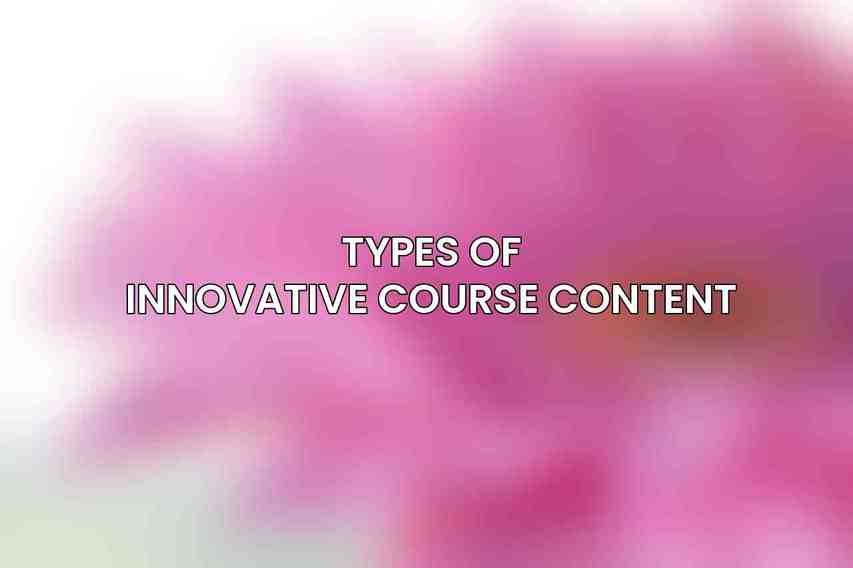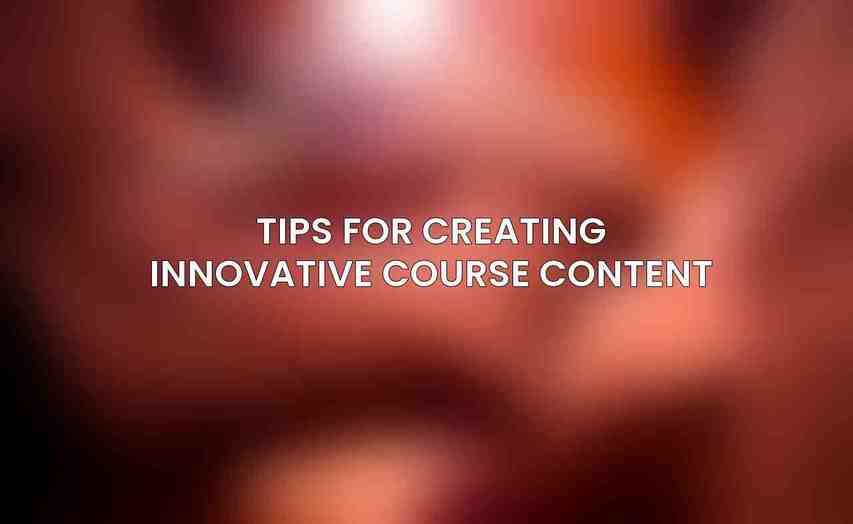Online learning has become a key aspect of education, especially in this fast-paced digital world. It is crucial for educators to create engaging and effective online courses to ensure that learners are motivated and able to grasp the content effectively. The need for innovative course content ideas has become paramount to improve learner engagement and overall learning outcomes.
Types of Innovative Course Content

Interactive Simulations
Interactive simulations offer a dynamic way to engage learners through hands-on experiences. This type of content includes:
Virtual Reality Experiences
- Immersive Learning Environments: Platforms like Google Expeditions and EngageVR provide immersive virtual environments that enhance learning.
- Examples: Students can explore ancient civilizations or dive into the depths of the ocean through virtual reality simulations.
Gamified Simulations
- Role-playing Games: By incorporating role-playing elements, learners can actively participate in scenarios related to the course content.
- Puzzle-based Challenges: Engaging puzzles and challenges can stimulate critical thinking and problem-solving skills.
Personalized Learning
Personalized learning tailors the course content to the individual needs and progress of each learner. This includes:
Adaptive Learning Platforms
- Tailored Content: Platforms like Khan Academy and Knewton adjust content based on the learner’s performance.
- Examples: Learners receive targeted lessons based on their strengths and weaknesses.
Microlearning
- Bite-sized Learning Modules: Breaking down content into smaller modules makes it easier for learners to digest information.
- Examples: Platforms like LinkedIn Learning and Udacity offer short, focused lessons on specific topics.
Collaborative Learning
Collaborative learning encourages interaction and cooperation among learners. This includes:
Virtual Class Discussions
- Real-time Interactions: Tools such as Zoom and Microsoft Teams enable live discussions and group activities.
- Examples: Students can engage in debates, group projects, and peer-to-peer tutoring.
Peer Review Platforms
Visual Storytelling
Visual storytelling uses multimedia elements to convey information in a compelling way. This includes:
Video Lectures Dive deeper into Mastering Video Content: Create Compelling Videos for Your Online Course
Infographics
- Clear and Concise Information: Infographics created using tools like Canva and Piktochart present information in a visually appealing and easy-to-understand format.
- Examples: Complex data can be simplified and presented in a visually appealing manner through infographics.
Immersive Experiences
Immersive experiences transport learners to new environments using technological advancements. This includes:
Augmented Reality (AR) Apps
- Overlaying Digital Content: Apps like Google Lens and Pokémon Go overlay digital elements onto the real world.
- Examples: AR apps can be used for virtual lab experiences, historical reenactments, and interactive storytelling.
Virtual Field Trips
- Remote Access to Locations: Platforms like Google Earth VR and Matterport offer virtual tours of real-world locations.
- Examples: Students can explore museums, historical sites, and natural wonders without leaving the classroom.
Benefits of Innovative Course Content
Incorporating innovative course content ideas can lead to a range of benefits for both educators and learners, including:
- Enhanced Learner Engagement and Motivation
- Improved Knowledge Retention and Comprehension
- Increased Collaboration and Peer Learning
- Personalized and Adaptive Learning Experiences
- Immersive and Memorable Learning Experiences
By embracing innovative content strategies, educators can create a more dynamic and interactive learning environment that caters to the diverse needs of learners.
Tips for Creating Innovative Course Content

To effectively implement innovative course content ideas, educators can follow these strategies:
- Identify Learner Needs and Learning Objectives
- Explore a Variety of Content Types and Formats
- Incorporate Technology Tools and Resources
- Seek Feedback from Learners and Iterate
- Monitor and Evaluate Content Effectiveness
By continuously refining and updating course content based on feedback and assessment, educators can ensure that the learning experience remains engaging and impactful.
Innovative course content plays a crucial role in enhancing online learning experiences and maximizing learner engagement. It is essential for educators to continuously seek new and creative ways to deliver content that resonates with learners in a digital environment. By exploring a variety of innovative course content ideas, educators can create dynamic and effective online learning experiences that cater to the needs of modern learners. Embracing innovation in course content creation is key to fostering a culture of continuous learning and growth in online education.
Frequently Asked Questions
What are some examples of innovative course content ideas for engaging online learning?
Some examples include interactive simulations, virtual reality experiences, gamified content, live Q&A sessions, and multimedia presentations.
How can I ensure that my online course content is engaging for students?
To ensure engagement, focus on interactivity, personalization, variety in content formats, real-world application of concepts, and opportunities for student collaboration.
Are there any tools or platforms that can help create engaging online course content?
Yes, tools like interactive eLearning authoring software, virtual reality platforms, gamification plugins, and video editing software can aid in creating engaging course content.
How important is it to update online course content regularly?
Updating course content regularly is crucial to keep students engaged and up-to-date with the latest information and trends in the subject matter.
What are some best practices for incorporating innovative course content ideas into online learning?
Some best practices include conducting learner surveys for feedback, incorporating storytelling elements, providing opportunities for hands-on learning, and integrating social learning components.

